Tara Donovan: Untitled opened at the Indianapolis Museum of Art last week. For this exhibition, the IMA commissioned Donovan to create a new room-sized installation that will appear along with five other major installations and fourteen drawings produced over the past ten years. As a special program for the exhibition, the IMA has invited Jill Sterrett, SFMoMA Director of Collections and Conservation, to participate in a panel discussion about issues related to Donovan’s and the conservation of installation art.
The panel discussion will be held at the IMA today, Thursday, April 8, and is called The Care & Feeding of Contemporary Art: Panel Discussion on Tara Donovan: Untitled.
Jill and I will be joined on the panel with Lisa Freiman, IMA Chair of the Department of Contemporary Art and Greg Smith, IMA Senior Conservation Scientist.
In order to have some of Tara’s thoughts represented at our panel discussion, I’ve invited Jill here to help me interview her (and create an extra installment of my monthly column, No Preservatives).
Richard McCoy & Jill Sterrett: Will you tell us a bit about your studio and your practice?
TD: I use the word experimental to describe my practice but that may be a bit of a misleading term, as I think the word has taken on a different meaning in the context of art. Although highly idiosyncratic, my approach is often much more clinical, similar to a scientist who allows research and findings to build into a hypothetical proposal. Over the years, I have refined certain categories and tendencies to guide this process, but I also remain very open to spontaneous discoveries, as I have learned that fleeting moments of observation often yield the most substantive approaches. My studio is organized as a “factory” in the sense that it is focused entirely on production, which requires a tremendous amount of repetitive labor.
RM & JS: In your recent conversation with Lawrence Weschler in the Institute of Contemporary Art catalog, you describe a moment when you were creating the ripped tar-paper installation Transplanted, in which the work became a kind of “expansive field.” Will you talk about the difference between a sculpture, an installation, and a landscape?
TD: My notion of the “field” is essentially co-opted from discussions of high modernist abstract painting, in which the edge of the canvas is understood as the only delimiting factor in what would otherwise be an infinite plane extending in all directions. For me, the architecture of a space is the only delimiting factor of my work. I don’t really invest too much thought into making precise distinctions between what is a sculpture, installation, or landscape. I think that debate and the resulting collapse of such categories occurred in the ’60s and ’70s, and contemporary artists such as myself get to enjoy the fruits of that polemic.
RM & JS: In looking at various installation shots of Strata (2000-2001), which is made from Elmer’s glue, we noticed that there is considerable variability about how the installation has appeared over time. This seems to be true for many of your installations. Can you talk about how Strata has evolved from the first instance it was created to how it appears now at the IMA?
TD: Each and every installation of my work contains inevitable variabilities that relate to space, context, and environmental/atmospheric conditions.
RM & JS: It’s impossible to view your work without marveling at the process involved in its creation. Will you talk about how process and outcome are both intertwined and distinct in your work?
TD: Process happens in distinct stages for me. I would describe my process as very personal and intuitive in the beginning and then very calculated and collaborative in the end. The challenging part is discovering an efficient transition between these two stages. Sometimes a material will sit in my studio for years before a transition announces itself. Once I decide upon how a material will transition, the process becomes entirely directed toward outcome.
RM & JS: The words ‘patience,’ ‘repetition,’ ‘control,’ and ‘surrender’ come to mind when thinking about the creation of your works, and also when viewing them. Do any of those words have a place when thinking about how they are made and viewed?
TD: I think all of those words are very relevant. I might also add (specifically with respect to production) the word ‘endurance.’
RM & JS: Since conservators often consider the hypothetical when developing preservation strategies, we’d like to present one to you: if the IMA or SFMoMA owned Colony and, for whatever reason, some amount of the installation became un-exhibitable, would it be possible for Jill or I to recreate a section if we made it look very similar to how it looks now? We know you work closely with a team of assistants to create your works, but what about museum professionals working on them when you’re not there to advise?
TD: Issues such as these are all addressed on loan agreements and sales contracts, but for the sake of addressing such a hypothetical situation in this forum, I would say no, it would not be possible for museum staff to recreate the work without the authorization and oversight of someone from my studio or gallery. While I am alive, these situations are very cut and dry. I am actually currently working on estate planning, etc., to address these issues in the future.
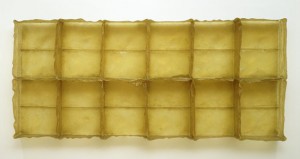
Eva Hesse, "Sans II," 1968. Collection of SFMOMA. Purchase through a gift of Phyllis Wattis. (c) The Estate of Eva Hesse.
RM & JS: In the Weschler interview, you talk about Eva Hesse as an artist who has amazed you because she was a woman working among minimalist artists and she wasn’t working with steel. She was working with ephemeral materials. Hesse presents a useful point of comparison on the topic of materials and studio practice. Her materials are not replaceable and her hand is integral to her artworks. Can you talk about how ephemeral materials and your hand relate to your artworks?
TD: Hesse is a significant inspiration and a constant influence for me. There are, however, critical distinctions to point out between her practice and my own when thinking about conservation. While we both utilize ephemeral materials, her materials are highly crafted by herself alone and not appropriated from the consumer realm. I think this is why her work has posed such incredible challenges for conservationists. Her hand appears highly personal and delicate, while whatever trace of my hand that appears on my work is actually very mechanical—essentially anyone can construct my work with detailed instructions. Also, materials are readily available to replace my work (although how this replenishment will occur when a particular object’s manufacture becomes obsolete is a tricky situation).
RM & JS: Your work borrows color from the light in the room and the shade of paint on the walls. How do light and color factor into your work, and has your approach to these factors changed over time?
TD: All of the atmospheric qualities of a room are really important when thinking about how my work will live in it. The only absolute standard is stark white walls in order to create a neutral palate in the room. Light has a mutability that can be controlled to develop an optimum scenario, whether or not it natural or artificial.
RM & JS: Your works generally appear to be exhibited in individual rooms or distinct spaces. Will you talk about the relationship between your work and the context or environment that it’s displayed?
TD: When thinking about my work in relationship to the spaces it inhabits, I use the term “site-responsive” as an alternative to what I see as the overuse and vagueness of the term “site-specific.” Because my work functions as a field of material that could extend infinitely, the architecture of the spaces it inhabits defines the volume of material used and scale of the final form. Every installation of my work must necessarily respond very intimately to the architectural surroundings.
RM & JS: Have there ever been exhibitions or opportunities that you have declined because the context didn’t fit your work?
TD: Yes. There have been circumstances where I have found that a curatorial theme imposes limitations. Exhibition spaces, as I have outlined above, are also obviously important in making a decision about whether or not to participate in an exhibition.
RM & JS: The staff at the IMA is really excited to be working through the process of acquiring the piece Untitled (Molecule), which was commissioned especially for this exhibition. Along the way, we’ve acquired a fair amount of documentation and an understanding about the materials and techniques used to create this work. With this in mind, can you give us some guidance on the long-term care and display?
TD: My studio, in collaboration with conservation specialists at my gallery, have put together extensive documentation and instructions regarding the construction, installation, care, and display of each work. I think the most obvious issue with any of my work, and especially for Untitled (Molecule), is controlling the build-up of dust in the tiny spaces that ultimately define the work. For this reason, adhering to storage specifications and scheduled cleanings becomes critically important.


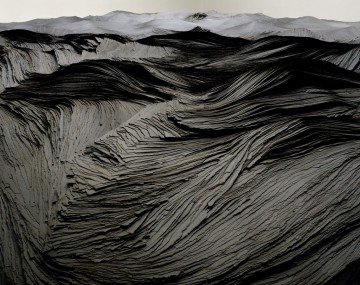

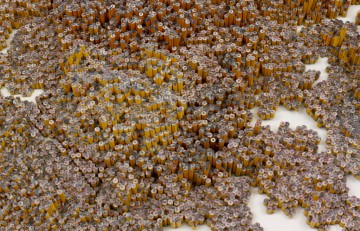
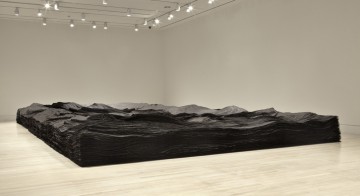
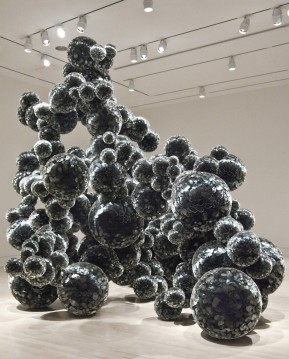
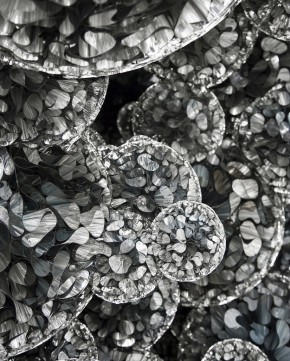



Pingback: Links we like:Tara Donovan Interview and Climate Control | Indianapolis Museum of Art Blog
Pingback: No Preservatives | A Fresh Path at the Met: A Discussion with Kendra E. Roth | Art21 Blog
Pingback: Artists to Look At « What Is Space
Pingback: Tara Donovan | Girls' Club
Pingback: Tara Donovan « Sarah Binless
Pingback: Tokujin Yoshioka: an Artistic Designer by Kendra Streilein | Adv. Painting
Pingback: Prelude: A Discussion with Tara Donovan | Tara Donovan
Pingback: Art: Tara Donovan’s Biomorphic Sculpture | Alex Kittle